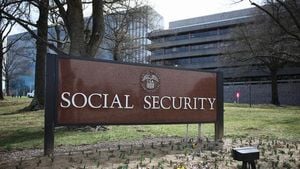Truong My Lan, the Vietnamese property tycoon embroiled in the world’s largest bank fraud scandal, is officially facing the ultimate penalty after losing her appeal against her death sentence. The 68-year-old was sentenced earlier this year for orchestrated fraud estimated at $12 billion, sending shockwaves through the country's financial system and highlighting deep-rooted issues of corruption.
Initially found guilty of masterfully siphoning off funds through numerous shell companies, Truong's case raised alarm bells within the Vietnamese banking sector, especially concerning the integrity of the Saigon Commercial Bank—Vietnam’s fifth-largest lender. The court's decision to uphold her death sentence confirms the severity of her actions, which prosecutors labeled as “huge and without precedent.”
According to reports, the nature of her embezzlement involved securing loans and cash over ten years, with authorities establishing at least $27 billion was misappropriated through pervasive deception. Such massive financial irregularities drew parallels to international cases like the infamous 1MDB scandal, which involved $4.5 billion, and even dwarfed the $8 billion scheme perpetrated by crypto fraudster Sam Bankman-Fried.
Yet, beneath the hard facts lies the human story of Truong My Lan. Born to modest beginnings within a Sino-Vietnamese family, she began selling cosmetics alongside her mother at local markets. Little did they know her entrepreneurial spirit would evolve, taking advantage of Vietnam’s economic reforms post-1986. Rapidly, she amassed considerable wealth, eventually chairing Van Thinh Phat Group, renowned for luxury developments across Ho Chi Minh City.
The dramatic courtroom scenes during her appeal showed Truong shifting from defiance to apparent contrition. She expressed her embarrassment over the drain on state resources due to her actions, stating: “I am embarrassed to have been such a drain on the state.” Despite her statements of regret, she must now raise $9 billion to have her death sentence commuted to life imprisonment, presenting her with the urgency of salvaging her legacy and potential survival.
Legal experts note the peculiar predicament she faces under Vietnamese law. If she can repay 75% of the $12 billion embezzled—a staggering task with many of her assets currently frozen—her sentence could potentially be mitigated. According to her lawyer, Nguyen Huy Thiep, “The total value of her holdings actually exceeds the required compensation amount,” but the nature of her assets, ranging from real estate to shares, complicates liquidity. The need to coordinate sales during her trial was hampered by laws restricting asset liquidation, affecting the potential for her to gather the necessary funds.
Truong My Lan’s case also ties back to the broader narrative of corruption crackdowns under Vietnam's government. The anti-corruption campaign, known as the “blazing furnace,” was led by Nguyen Phu Trong, and is believed to have exposed systemic issues within the management of finance institutions, including the involvement of various state officials. This campaign has caused significant disruptions, leading to slowdowns in government projects and license approvals, raising concerns over Vietnam’s aspirations of fostering foreign investment.
The wake of Truong’s case hasn’t just shaken domestic stakeholders but sent ripples across international investor confidence too. Financial analysts suggest the fraudulent activities and the resultant investigation may wear heavily on Vietnam’s ambitions to position itself as a major manufacturing hub, especially as global dynamics shift. Corruption has lingered as both a concern and a barrier to Vietnam's economic advancements.
The trial had attracted significant media attention, illustrating the cutthroat world of Vietnam’s elite and the risks inherent within power structures. The fact over 85 defendants were similarly convicted, ranging from members of her own family to numerous bank executives, lays bare the extent of the fraudulent network she operated within.
Truong My Lan is not done fighting yet. While her appeal has been dismissed, there still exists the possibility for her to petition the president for amnesty or seek another review. Though few expect her pleas to move the judges, the looming shadow of execution acts as both the motivating force and dire reality of her situation.
Reflecting on the volatility of Truong My Lan’s beloved country—where the risk of exposure could threaten anyone at the heights of power—it amplifies the concerning intersection of wealth, crime, and accountability. On the cusp of nadir or reclamation, as the narrative of the decline and rise continues, she stands as more than just a fraudster. She embodies the complex dualities of opportunity, ambition, corruption, and the rigorous lens of justice.



